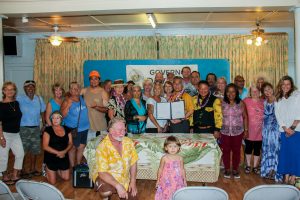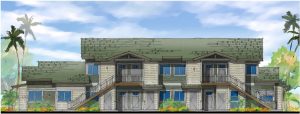
Lahaina, Maui residents celebrate a new law to produce and preserve more affordable rentals on the Valley Isle.
The Ige administration is ramping up the state’s efforts to provide more housing for low-and moderate-income families. “Our goal is to create as many affordable units as possible — especially for families in the 30 to 60 percent area median income range,” said the governor.
On Maui, Gov. Ige signed SB 2293 that aims to produce more affordable housing on the Valley Isle, while preserving affordable rentals at the Front Street Apartments in Lāhainā. The new law mandates the Hawai‘i Housing Finance and Development Corporation (HHFDC) to begin the process of condemning the ground lease. It also appropriates $30 million from the state’s Rental Housing Revolving Fund to expedite the development of 200 multi-family rental units at the Keawe Street Apartments in Lāhainā. In Kaka‘ako, the governor joined the Hawai‘i Community Development Authority in signing amendments to HCDA rules that stipulate units in the area must remain affordable for at least 10 years. “Thanks to HCDA chair John Whalen and the board for listening to the community,” said Gov. Ige.“It’s about balancing production and affordability to make more units available for our residents.”

Phase I of Keahumoa Place near the Kapolei Rail Station will provide affordable family rentals for 65 years.
Three more O‘ahu projects also got under way last month with state-assisted financing. They include Waipahu Tower, an affordable rental housing project for families earning 60 percent and below the area median income (AMI). The eight-story building is an acquisition/rehabilitation project set to remain affordable for 59 years. A second project is Nohona Hale in Kaka‘ako, being built on state HCDA land near the HART rail station. The 111 micro-units also received state financing assistance and are targeting families earning 30 to 60 percent AMI. The third project is Keahumoa Place, a 320-unit planned community near the Kapolei Rail Station. Phase I will consist of 75 units and will provide affordable family rentals at 60 percent AMI for 65 years. Estimated completion for Phase I is 2019-2020.